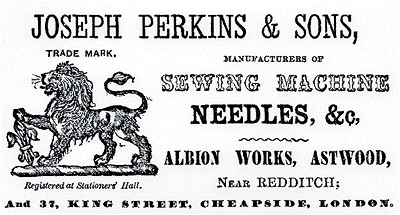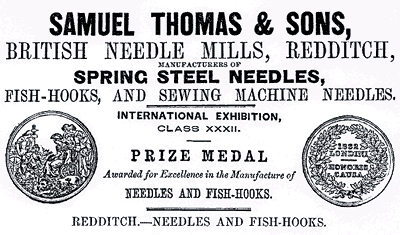


Redditch Needles. Situated to the south west of Birmingham, the town of Redditch first established a needle making reputation as early as the 17th century. Initially this was a cottage industry but during the 19th century developed into factory based production. By the mid 1800s dozens of individual companies were engaged in the trade. Products included fish hooks, surgeons’ and sewing needles. The development of the sewing machine during this period opened a lucrative new market. To meet this need, several local companies including Joseph Perkins & Sons, Thomas Shrimpton & Sons and Samuel Thomas & Sons added machine needles to their prospectus. Their raw material was high quality steel wire, sourced from both nearby Birmingham and more distant Sheffield, renowned as the steel making capital of Britain. By the 1870s, Sheffield steelmakers such as William Smith, Joseph Dyson, Joseph Wordsworth and Jagger Bros. advertised their steelware to Redditch needle makers. It has been estimated that by this period the town was producing many millions of needles annually, thereby dominating the UK market. |
 |
An article in The Art Journal for September 1862 described a display of products from Samuel Thomas & Sons at the London International Exhibition of that year. “The series of cases which almost exclusively contain Needles and Fish-hooks demand their own share of attention amongst the notabilia of the Exhibition. Redditch, near Birmingham, is the locality which produces these two distinct yet closely allied manufacturers, and Redditch is most honourably represented at South Kensington. The case that is by far the most remarkable of the group, and which may fairly be selected for especial notice, is that of Messrs. S.THOMAS and SONS, British Needle Mills. It is a truly remarkable production, as well for its contents as for the manner in which they have been made to produce an elaborate and beautiful decoration. In the first place, the actual manufacture of Needles is illustrated by means of sixteen distinct collections of examples of the progressive operations of the manufacturer. First, there is the coil of fine steel wire; then the attention of the visitor is attracted onwards through the following series of objects:— the wire cut in 'lengths' for two Needles, these lengths 'straightened,' then each length 'pointed' at both ends, 'stamped' for the formation of the eyes, 'eyed,' 'spitted' through the middle of each length, 'filed,' 'divided,' to produce two Needles from each length; next the divisions are 're-filed', 'hardened,' 'ground,' 'blued, "drilled, "scoured,' and finally they appear 'finished' as perfect Needles. Thus this collection carries the observer on from step to step, and practically familiarises him with the manufacture that takes so important a part in universal industry. The Fish-hooks are exhibited in heaps, tempting indeed to every piscatorial eye, and they exemplify every possible variety of the delicate yet formidable implement that seals the doom of the finny races. The progressive stages of this Fish-hook manufacture, however, are not illustrated in the same manner as in the instance of the Needles. The fine temper of the steel must be assumed, but the exquisite workmanship that has wrought these slender yet strong and sharp instruments is palpable enough, and commands the warmest commendation." |
 |
It would appear the industry was not immune from fraudulent activities. The following is taken from a report concerning an injunction in the Chancery in May 1863. "The acknowledged superiority of the Needles manufactured by Messrs. S.Thomas and Sons has had the result of inducing unprincipled persons to adopt a fraudulent imitation of the name of their firm, and of the trade marks and labels which they use. In May, 1863, Mr. Thomas filed a bill In the Court of Chancery against Edward Cook and William Adams, and moved for an injunction "to restrain the fraudulent use by the defendants of his trading style, his trade marks and labels, or any colourable imitation or counterfeit thereof." The case came on for hearing on the 28th of May, before Vice-Chancellor Sir W. Page Wood, and It was then shown in evidence that Cook, who had been in the employment of plaintiff as clerk and bookkeeper, was discharged in October 1862. He then determined to turn, by' a fraud on the public, the knowledge he had gained of plaintiff's business to his own purposes, and having discovered at Worcester a poor old man named Thomas, he, in conjunction with Adams, entered into partnership with him, and the firm assumed the name of "S. Thomas and Co.“. The pretended firm, on commencing operations. gave notice to the postmistress at Redditch to forward all letters addressed S. or Samuel Thomas and Co., to the dwelling-house of Adams. The result was that they received many letters Intended for plaintiff. They got labels closely resembling those of plaintiff in type, size, and colour, and having placed them on needles of an inferior quality, canvassed largely for orders in Canada and elsewhere, stating in a letter to a firm in Montreal, whom they wished to become their agents in Canada, "we believe that Thomas’s needles are in demand in the Canadian markets”. After hearing the application, and the learned council who appeared for defendants, the Vice-Chancellor , without calling for a reply, said, comment was almost thrown away in such a case, the gross fraud which the defendant Cook had committed being so palpable that it did not require a moment’s discussion. Not being of the name Thomas, and wishing to defraud his former employer, he bought up a poor old man of the name Thomas in order to concoct the fraud. He then endeavoured to forge the labels of plaintiff, only putting “and Co,” instead of “and Sons,” and sent some of the plaintiff’s labels, which he did not explain how he had obtained, to a printer to be copied. When he found that the printer was too honourable to engage in such a fraud, he contrived to get back the letter in which he ordered the labels, and then denying the letter, he (Sir Page Wood) was afraid that Cook completed by perjury his attempt to conceal his fraud. He did not for a moment disbelieve the account of the letter given by the printer, and did disbelieve everything which a man like Cook ventured to say, or swear, which was not corroborated by the strictest possible evidence. If anything could add to his moral depravity throughout the whole transaction, it was writing, as he did write, to another person, advertising to send goods to Canada, putting in the margin “not connected with Thomas and Sons,” while he said in the same letter “Thomas’s needles are known in Canada,” though it was admitted that he never sent needles to Canada, perhaps never having manufactured one. He thought this was one of the most gross cases that had ever come before the court." GD |
© All content copyright protected.